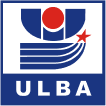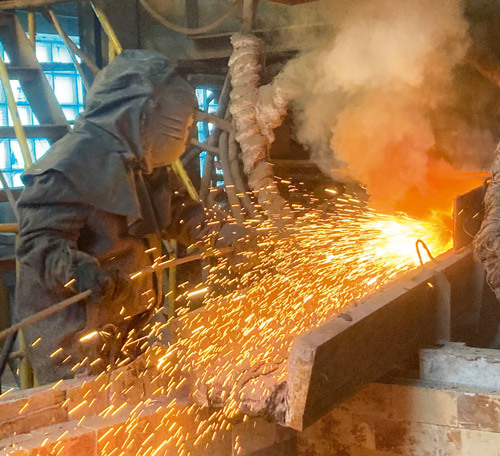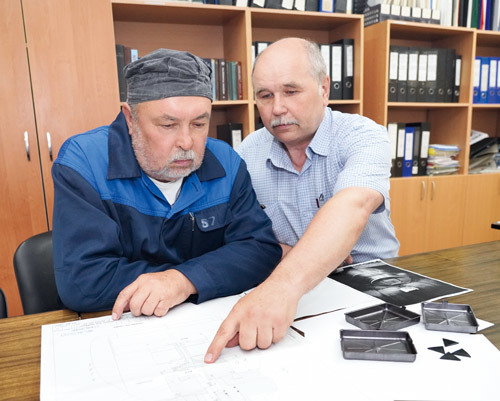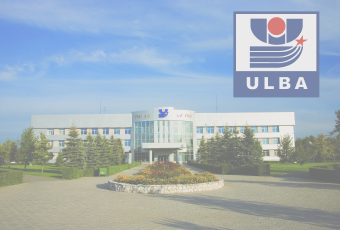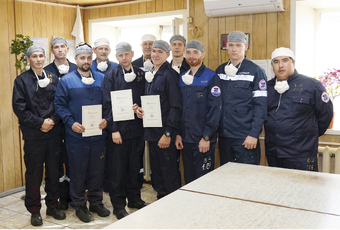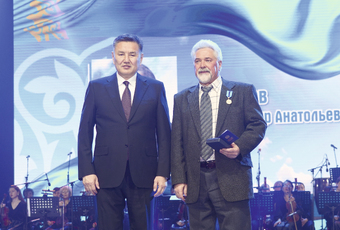About the best in detail
About the best in detail
In the previous issue of UMP-inform, we announced the results of the annual competition «Innovator of UMP JSC». In this issue, read a detailed story about the winners and their «know-how».
In the group of auxiliary industries in the nomination «The best rationalization proposal of the year», the Power Center – «Change of the external energy saving scheme of UMP JSC with the commissioning of power transmission line No. 116» was recognized as the winner. The authors of the work are Andrey Vykhodtsev (PC), Evgeny Efimov and Adilzhan Orzhanov (both from TPDS). UMP is supplied with power according to an external scheme, which includes five overhead power lines with a voltage of 110 kV. Two transmission lines No. 141 and No. 142 are owned by our plant, they are the main ones and have been in operation since 2002. Other power lines are standby, used during the repair of the main electrical equipment. Our transmission lines are connected directly to KEGOC's interregional networks.
The costs of purchasing energy from energy-producing companies are impressive, and therefore UMP power engineers have developed a proposal to reduce costs. The bottom line is this: rent one of the reserve overhead lines and change the external power supply scheme. This line is a «deep input» of the power supply of the plant, i.e. connected directly to the buses of the Ust-Kamenogorsk CHPP and to the buses of the plant substations. There are no other consumers powered by this line. The rent will reduce the cost of purchasing electricity by eliminating the transit of 50% of the volume of purchased electricity through KEGOC networks. Thus, the power supply of the plant is now carried out through its own overhead line and one as rented. This scheme cut costs!
In the same nomination, the winner in the group of main industries was the proposal of UO – «Restoration of the support unit of the centrifuge screw N-300B», the authors of which are Evgeny Kovtun, Vladimir Antropov and Alexander Shushanikov (all from UO). Centrifuges N-300B have been used at UO for more than 30 years in the process of ADU precipitation and filtration. In total, more than 15 units are in operation. During operation, the removal of the precipitant (amsalt) from the centrifuge is carried out by the lower screw. For many years of continuous operation of the equipment, under the influence of loads and after repeated repairs, deviations from the geometric shape of the surface and violation of the dimensions of the seat occur. This leads to the formation of increased vibration, which is unacceptable during the operation of a centrifugal high-speed apparatus. The order and manufacture of a new screw at the Mashzavod costs too much. The cost of the auger is about one million tenge, that of the the supporting part makes 500 thousand. The authors proposed to apply the technology for restoring the centrifuge screw support assembly. Firstly, worn screws should be rejected individually according to the types of deviations from the geometric shape and the size of the surface wear (tapering, ovality, fit tolerance). Secondly, the H7 hole should be finished on a boring machine of the Mashzavod using a device specially designed for this operation. Thirdly, for the final assembly of the centrifuge screw support assembly with an increased size, use pre-prepared cups restored by surfacing, followed by processing on a screw-cutting lathe. All this is done by the guys from the mechanical service, and the main direct participation in the implementation of the rationalization proposal into production was carried out by the repairman Alexander Molyavko, who is currently on a well-deserved rest. The use of this technology made it possible to restore the efficiency of the centrifuge screw, extend its service life and eliminate the purchase of an expensive repair unit. Since last year, UO employees have restored about six nodes.
In the nomination «The most original rationalization proposal of the year», the prize-winning place was shared by the rationalization proposals of tantalum and beryllium production. TP proposal – «Changing the technology for the production of tantalum pallets according to the drawing C-34373-01 T8 for AVX by using an expansion spacer for stamping.» It was proposed by Nikolai Lebedev and Nikolai Gorokhov. One of the types of finished products of TP is pallets made of tantalum modified with yttrium. The main purpose of tantalum trays is their use for high temperature annealing (temperature 1800 Celsius) of capacitor cases and terminals. The production of tantalum pallets is carried out by sheet stamping on a press with a force of 1,000 ton/force. Previously, TP workers cut out edges, rolled, welded, riveted the side walls of pallets, this was a very laborious process with a low yield into finished products. When stamping tantalum pallets, a large percentage of cases were obtained with stripes, folds and breaks in the corners of the products. To eliminate these defects, Nikolai Gorokhov and Nikolai Lebedev suggested using compensating spacers for stamping. Simply put, when stamping pallets, geomembrane corners are laid along the edges of the lower stamp, which makes it possible to obtain pallet corners without visible defects after stamping. The advantages of the proposed solution are improving the quality of the appearance of tantalum pallets, reducing the cost of manufacturing equipment for stamping finished products and reducing the time for its production. The technical properties of the pallets have not changed since the implementation of the solution. TP workers have been using this technology for two years already. The main customer, AVX, has no complaints about product quality. At the moment, the contract for the supply of pallets is concluded until April 2023.
The authors of the rationalization proposal BP – «Use of waste fireclay bricks ShA-1 with electric arc caisson ore-thermal furnace (RTF) for mold lining for ferroalloy discharge» – BP workers Evgeniy Sokolov and Ivan Lysyak. At the beryllium production, ferro-alloy is poured out in a steel lined mold, which is a rectangular box, in which the side walls and the bottom part are lined with fireclay bricks. It takes 766 fireclay bricks ShA-1 to carry out one lining of a steel mold for one discharge of ferroalloy. During the operation of the caisson ore-thermal furnace (CRTP) once a year, a planned lining of the melting chamber of the furnace is carried out using fireclay bricks. Approximately 11 tons of bricks are required for the lining of the CRTP melting chamber, respectively, this amount of used brick is removed to the tailing pond in the form of waste. The disadvantage of this provision was the formation of a large amount of waste, as well as the acquisition of an additional amount of fireclay bricks. When lining the CRTP, the brickwork does not have physical wear (due to the skull), and the brick actually retains its integrity. The authors proposed to use the spent fireclay brick for the second time when lining the mold for ferroalloy draining. The advantages of the rationalization proposal are a reduction in material costs for the purchase of an additional volume of fireclay bricks and a reduction in the volume of solid waste.
By Samal Iskakova





